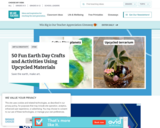
30 crafts you can do at home or school with recycled materials. Get Creative!
- Subject:
- Arts Education
- Visual Arts
- Material Type:
- Activity/Lab
- Author:
- Jessica Mcfadden
- Posted Jessica Mcfadden
- Date Added:
- 06/01/2020

30 crafts you can do at home or school with recycled materials. Get Creative!

In this art history video discussion Beth Harris and Steven Zucker look at Albrecht Durer's "Self-Portrait, 1500." (Alte Pinakothek, Munich).

This art history video examines the "Alexander Mosaic" c. 100 B.C.E., tessera mosaic from the House of the Faun, Pompeii. This Roman floor mosaic may be based on a lost Hellenistic painting by Philoxenos of Eretria, The Battle of Issus, c. 315 B.C.E.). Museo Archeologico Nazionale, Naples.
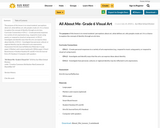
The purpose of this lesson is to reveal students’ perceptions about art, what defines art, why people create art. It is a chance to explore the concept of identity through an arts lens.
Curricular Connections
• CR 6.1 – Create personal responses to a variety of arts expressions (e.g., respond to music using poetry, or respond to visual art using music).
• CR 6.2 - Investigate and identify ways that the arts can express ideas about identity.
• CH 6.1 - Investigate how personal, cultural, or regional identity may be reflected in arts expressions.
Assessment
Arts Ed Journal Reflection
Materials
• Large paper
• Markers and crayons (optional)
• White paper
• Smart Board lesson
• Student Handout #1 and #2
• Arts Ed Journal Entry #1 Handout
• Computer with speakers

Children’s drawings have a wonderful inventiveness, energy, and variety.
Bring children's drawings to life by animating characters to move around!

This site explores the elements of art and principles of design with videos, examples and lessons.
The elements and principles of design are the building blocks used to create a work of art.
Elements of Art are the visual "tools" that artists use to create an art work - they are what makes up an image or an art object: line, shape/form, value, color, space, and texture.
Principles of Design are the ways artists use the Elements of Art in an artwork - this is "what we do with the Elements" - how we arrange them, how we balance them, what is being emphasized, etc. The principles are: balance, contrast, repetition, emphasis, and unity.
Be sure to check out Art 2 - Lesson plans for intermediate Art program @ https://resourcebank.ca/courses/art-1-lesson-plans-for-beginner-art-program

Art 2 offers a two semester program:
Semester 1
Focus on drawing skills:
creative drawings, shading techniques review and practice, pen and graphite drawings, texture shading, colored pencils and oil pastels techniques, design stylizing techniques, non-traditional art media, mix-media, introduction to watercolor pencils, watercolor techniques, etc.
Semester 2
Focus on drawing, painting and printing media:
unusual painting media, creative designs - practice eye-hand coordination, pen and ink drawings, pattern values and creative application, introduction to silk screen printing, optical illusions and OpArt - review perspective, collages and acrylic paintings, composition and colors in Art.
Be sure to check out Art 1 - Lesson plans for intermediate Art program @ https://resourcebank.ca/courses/art-1-lesson-plans-for-beginner-art-program-2
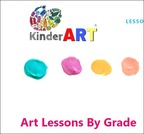
Here you can browse through art lesson plans by age or grade, from Preschool through High School.
The site includes a "What you can expect" of students artists at each age level.
At KinderArt "Our mission is to create and provide art lesson plans that parents and teachers can use in their home and school classrooms. We aim to offer ideas that make use of readily available materials that won't break the bank."
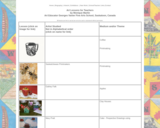
Art Lessons for Teachers
by Monique Martin
Art Educator Georges Vanier Fine Arts School, Saskatoon, Canada
Includes: printmaking, sculpture, perspective drawing, colours, mixed media, chair design, clay, architecture, cultural art, drawing, painting, quilting, and much more!
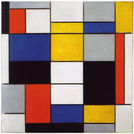
Some great visual resources that meet outcomes from the grade 6 curriculum.

This collection of art videos will support teachers and students in their quest to learn more about art.
Videos include: Matisse, Chagall, Michelangelo, pointillism, Britto, Chinese Dragon, Dali, Pollock, Tin Art, Kindness Rocks, Landscapes, Fashion Design, Collaborative Portraits, Zentangle, Howard, Dhurrie Rug, Magritte.
There are great ideas for lessons here, information about famous artists and great individual or collaborative projects.

Students will learn about axial movements and locomotor movements by discussing dancers depicted in a drawing and photograph. They will then practice combining axial and locomotor movements. They will describe how artists depict a dancer's motion in drawing and photography. They will also analyze how an artist creates movement and emphasis through contrast, composition, and leading lines, and then experiment with photography to capture motion in dance.
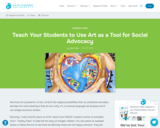
Art can be a platform for social change because it reaches deep into our souls and speaks a visceral language we all understand.
Art serving as a tool for social activism or social healing is not new, but as art educators, we need to be reminded of this.
We can teach students that art can affect global change. This site gives ideas of how to get started.

Art tutorials on various art mediums and art by subject matter.
Includes paint of all kinds, pencil, pastel, mixed media and more.

Teachers can search their database for lesson ideas and art history assignments.

This site offers visual and performing art lessons from kindergarten through high school. Many of the lessons can be integrated into core subjects such as Math, Language Arts, Science, or Social Studies. Opportunities for creativity are some of the building blocks of child development and concept acquisition. Lessons are categorized by grade for easy retrieval.
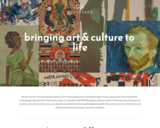
Leading museums share their collections through virtual, augmented and mix reality.
Bringing the arts to life through virtual, augmented and mixed reality, Boulevard is reshaping the landscape of storytelling and revolutionizing the way the world looks at art and culture.
The "Educate" and "Experiences" tabs are a great place to start.
There are full lessons in here under "Educate"!

In this 7 lesson unit plan students will use symbols to create a mixed media sculpture that represents their identities.

The AGO’s collection is searchable on their website, but some exhibits stand out more than others.
One gem on the website right now is The Boxwood Project, which contains countless photos of exquisitely tiny gothic carvings, accompanied by not just one scientific analysis showing how researchers figured out how the beads were made, but numerous essays on the topic.
Another feature is an interactive website compiling around 3,000 photographs taken by Henryk Rozencwaijg-Ross of the Jewish ghetto in a Polish city during the Holocaust. Visitors to the webpage are encouraged to use the “Build My Collection” function to curate their own exhibit out of the photographs and share it with others.

Students use washable paints, markers, and construction paper to illustrate a month from the traditional Cree Calendar
Students will be able to:
illustrate a month from the traditional Cree calendar;
demonstrate an understanding of the changes, cycles and patterns that occur in nature through words and images;
draw/paint geometric and organic shapes;
create the illusion of depth in space using size;
connect personal life experiences to their artworks.